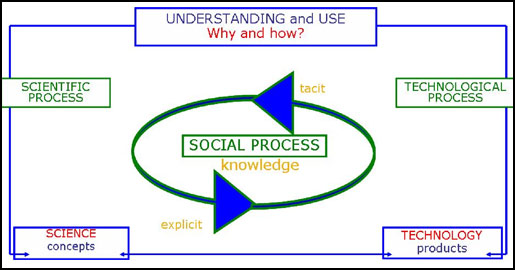
ATLAS e-News
23 February 2011
Knowledge transfer from creation to innovation
A new study for the five LHC experiments at CERN
5 May 2008

Knowledge creation pattern: from the individual’s learning process to knowledge acquisition in an organizational context and the knowledge transferred from CERN to other institutions.
How often have you asked how much knowledge is generated and transferred from the ATLAS experiment? A study from Helsinki University and CERN, entitled “Knowledge creation and management in the five LHC experiments at CERN: implications for technology innovation and transfer” makes a detailed analysis of individual perception, assessment, context and tools in which ATLAS and the others LHC experiments in general evolved and track the various aspects of knowledge acquisition and transfer. The data from ATLAS were collected at a big collaboration meeting in Paris whereas the data from the other LHC experiments have been collected at collaboration meetings and through individual contacts.
By the frequency, breadth, and depth of information exchange, relation-specific common knowledge is created. Common knowledge is required for learning to occur between exchange partners and diversity of knowledge is necessary for the transfer of new knowledge to occur. This knowledge generation is of particular importance for economists and sociologists as it is at the basis of societal and technological innovation and is also of relevance for the industrial world.
The study confirms, with quantitative data, and conceptualizes the role CERN plays in creating knowledge as a leading organization in the field of HEP. From the collected data a large amount of knowledge transfer has been assessed with particular emphasis on the management and coordination acquisition (positive answer from 32% of the respondents).
The potential of Big Science centres may well be currently under-utilized in industry. Specifically, paying more explicit attention to the management of technological learning could enhance the spectrum of technological impact. So far, economic returns have been monitored evaluating industrial return to member countries from purchasing. The total economic benefit resulting from technological learning in industry greatly outweighs this aspect as indicated by the study. It is to be noted that in LHC experiments almost 50% of the participants are not from CERN Member States. This means that spill-overs of technological learning are today worldwide.
Big Science centers as well as the contributing member countries should encourage and prepare the terrain to make possible the collaboration with industrial companies and make better known the impact scientific achievements have on society. The results underline the importance of management in large physics collaborations (94 of 291 respondents had a management and coordination role in addition to their physics or engineering functions). Furthermore, management is acknowledged to be important and useful for the career by almost 50% of the respondents. Interactions between individuals in the project team who have common interests are important parameters for knowledge transfer which is extended by the interactions between experiments. The interaction among the project members was facilitated by the organizational structure of the collaboration and by the frequent use of available communication tools. Individuals were able to create and expand knowledge through the social process which also involved industry in various phases of the project development. Furthemore personal outcomes of knowledge transfer have been substantial in all LHC experiments. These were assessed in terms of the widening of scientific interests and knowledge as well as expanding the social networks and enhancing of scientific skills at many different levels (planning, data analysis, paper writing) with the acquisition of new technical and technological skills. These positive outcomes have been observed in a population of 79% users and 21% of staff members, span over a wide age range, benefitting both young and experienced physicists. The domains of technological learning useful for the career span from physics, to detector technologies, electronics, information technologies and management and the many innovative developments have been categorized by fields (i.e. detector technologies 41%, computing 33%, electronic 25%). The development of personal skills, according to four identified factors (learning of technical skills, learning of science making skills, improvement of social network, and increase of employment possibility in labour market) should be managed, used and catalysed to target individual development in order to improve opportunities in the labour market for the individuals working in HEP environments. The researchers who responded to the study have shown a positive approach towards going to work for companies or to create their own company.
These results should encourage further inquiries into the corollary learning and innovation impact of Big Science centres in innovation systems. We hope that the summary reported here will trigger your interest and incite you to know more about the result of the enquiry to which you participated.

Beatrice BressanHelsinki Institute of Physics
|